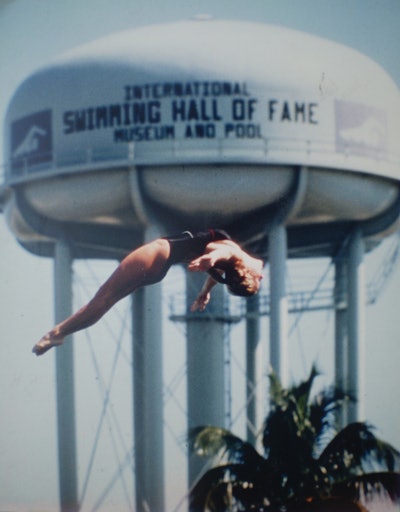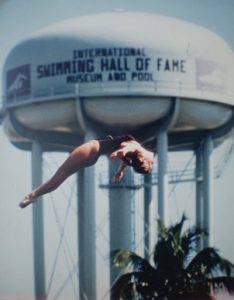In an ironic twist, the organization dedicated to honoring athletes and contributors of aquatic sports is being celebrated themselves, as the International Swimming Hall of Fame (ISHOF) passes a century since its small beginnings in Fort Lauderdale, Fla.
The ISHOF made its start in the 1960s following a boom in aquatic sports after the Second World War, but its earliest beginnings can be traced back to 1928, when the inaugural Casino Pool opened in Fort Lauderdale.
Almost a century later, the ISHOF stands firm in the city of Fort Lauderdale and ardently pursues its mission to “Inspire, Immortalize, Imagine.” AQUA spoke to ISHOF Board Chair Bill Kent to reflect on the major accomplishments of the last century and look toward the years to come.
“I was inspired — or infected, depending on how you look at it,” Kent quips, reflecting on one of the first ISHOF board meetings he attended. “Since I was local to the area, I just kind of got involved. I was on and off the board for about five years.”
About 20 years after his first meeting with the ISHOF, he became the chair of the board on two conditions: first, that the ISHOF remain in Fort Lauderdale (a new contract with the city was due to be signed); and second, that the now-iconic Every Child a Swimmer program be revived.
“There was a huge amount of community support from the people of Fort Lauderdale,” Kent shares. “The Hall of Fame leadership talked about leaving in the 1990s, which eventually led to a loss of that support from not only the community, but from the government. It was important to me for the organization to stay in the same city that it began.”
Over the last century, countless great things have been accomplished; when asked to summarize a few of the biggest, Kent cites the vast number of people who have since been inducted into the Hall of Fame and the strong connection fostered between Fort Lauderdale and the organization.
With the help of Johnny Weismuller, who was the organization’s first board chair in 1965, the city gained significant attention from tourists and aquatic sports enthusiasts alike. This created a deep connection between the people of Fort Lauderdale and the Hall of Fame, which remains a stronghold for aquatic sports to this day.
 A century of swimming history: The International Swimming Hall of Fame continues to celebrate aquatic legends while expanding its vision for the future.
A century of swimming history: The International Swimming Hall of Fame continues to celebrate aquatic legends while expanding its vision for the future.
But things aren’t slowing down for the ISHOF. “That’s the most exciting part,” he says eagerly. “We have what’s called the 3P Project, which stands for Public, Private, Partnership. This project will include an aquarium in the next building built for the Hall of Fame, which will bring in even more tourists. We’re going to increase parking, there’s going to be a restaurant on the top of the building, we’re expecting it to be a hit!”
Historically, Kent admits, the Hall of Fame was never a big draw for tourism outside fans of aquatic sports. The goal with this major facility is to attract visitors from all walks of life and thus, garner more attention for the organization, the sport and the city in general.
Beyond Fort Lauderdale, Kent expresses enthusiasm for the expansion of the Every Child a Swimmer program, which he says he plans to “take global” over the next few years. “We know that around 300,000 people drown each year, according to the World Health Organization. A large percentage of those drowning rates come from less developed countries, so we need to take the program to places where the need is greater.”
Emphasizing an awareness of high drowning rates and encouraging swim education, the Every Child a Swimmer program is designed to brighten the future of swimmers around the world, and work to decrease the amount of lives lost to drowning. “A lot of those numbers also come from kids between the ages of one and five,” Kent continues. “Education has to be pointed toward parents as well, so they can understand the reality of drowning. Only then can they take more action to prevent it from happening.”
The goals for the ISHOF are growing ever larger, the outreach is ever wider, but the original mission statements still ring true: to inspire, immortalize and imagine. Much of this comes in the form of the museum and its expansive library of memorabilia from the last century.
“People started sharing medals and all kinds of memorabilia related to the evolution of aquatic sports, going back to the very beginnings of the revitalized Olympics in the early 1900s,” Kent says. “We have an incredible collection of significant memorabilia that relate to the relationship between water activities, aquatic activities, and the evolution of the human race, going all the way back to Ancient Greece, 3,000 years ago. In short, we’re a resource for the history of the relationship between the human race and aquatic activity.”
This article first appeared in the October 2025 issue of AQUA Magazine — the top resource for retailers, builders and service pros in the pool and spa industry. Subscriptions to the print magazine are free to all industry professionals. Click here to subscribe.






